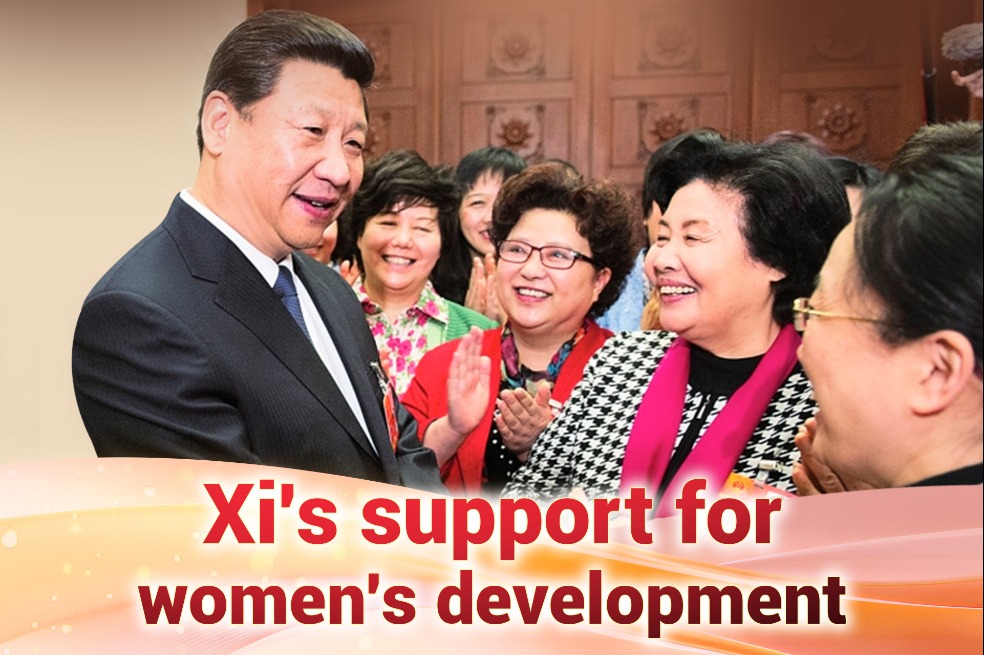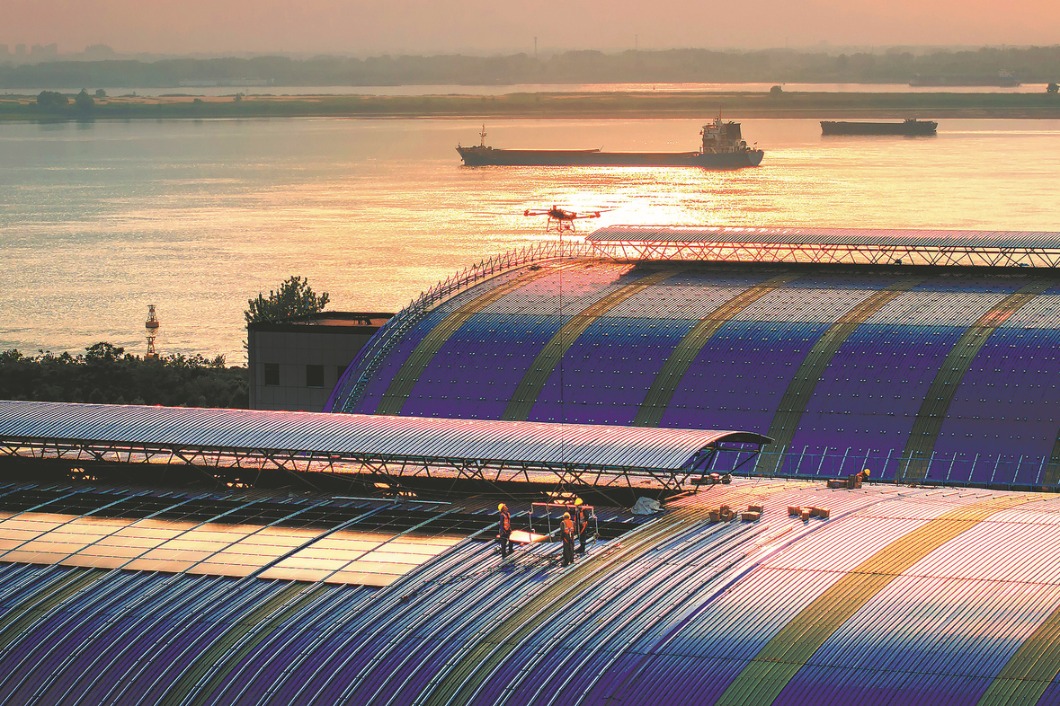Up to the hub


Since its launch, the Belt and Road Initiative has evolved from a grand vision into tangible achievements, becoming a significant practice in advancing the building of a community with a shared future for humanity. As a crucial hub along the ancient Silk Road, the Xinjiang Uygur autonomous region has leveraged its unique geographical advantage to assume a key role in the building of the Silk Road Economic Belt.
Positioned as a core area of the BRI, Xinjiang has accelerated its opening-up significantly, yielding substantial progress in trade, economy and other fields.
Xinjiang's foreign trade volume has continually expanded since 2013. Between 2013 and 2024, the total value of its goods trade increased from $27.56 billion to $61.17 billion. Specifically, during the same period, exports rose from $22.27 billion to $52.01 billion, while imports grew from $5.29 billion to $9.16 billion. Xinjiang has consistently maintained a trade surplus, demonstrating a clear export advantage.
In terms of trading partners, Xinjiang maintains the closest ties with Central Asian countries. In 2024, bilateral trade volumes with Kazakhstan and Kyrgyzstan reached about $22 billion and about $15 billion, respectively, underscoring Xinjiang's important position in trade with Central Asia.
In terms of foreign direct investment inflows, Xinjiang utilized over $600 million in FDI in 2023. Meanwhile, as Xinjiang's overall economic strength has continued to grow, its outbound direct investment has also expanded. This reflects Xinjiang's evolving trend from primarily receiving capital inflows toward a more balanced and dynamic two-way investment.
Across prefectures and cities in Xinjiang, the northern slope of the Tianshan Mountains has emerged as the core hub for FDI concentration. Cities in Southern Xinjiang, such as Kashgar and Hotan, have recorded significant growth rates, demonstrating the effectiveness of targeted policy support and adjustments in industrial planning.
In terms of the degree of opening-up, Xinjiang has established a multi-tiered platform for opening-up.
First, the region now operates 20 national-level ports. Key ports, such as Horgos, Alashankou and Irkeshtam, have become vital hubs linking China with Central Asia and Europe.
Second, the China (Xinjiang) Pilot Free Trade Zone is driving continuous improvements in the business environment and industrial agglomeration through institutional innovation. Its three key areas — Urumqi, Kashgar and Horgos — are entrusted with the critical mission of deepening opening-up and cooperation with Central Asia and Western Asia.
Third, cross-border economic cooperation zones in Yining, Tacheng, Bole and Jimunai, along with the China-Kazakhstan Horgos International Border Cooperation Center, are being developed into demonstration zones for Asia-Europe economic and trade collaboration.
Fourth, comprehensive bonded zones in Urumqi, Kashgar and Horgos, together with numerous high-tech industrial development zones, economic and technological development zones, and industrial parks, provide robust support for Xinjiang's industrial upgrading and expanded openness.
These platforms complement one another, collectively forming a multidimensional, integrated framework for openness that significantly advances the development of Xinjiang as a core area of the Silk Road Economic Belt.
While achieving remarkable successes, Xinjiang also faces several practical challenges as it deepens the development of its role in the BRI, particularly in economic and trade cooperation.
On the one hand, sluggish global economic recovery, regional geopolitical volatility, and unilateralist and protectionist measures adopted by certain countries have introduced significant uncertainties into cross-border trade and investment, potentially undermining the stability of industries and supply chains and hindering the steady progress of cooperative projects.
On the other hand, as Xinjiang actively attracts industrial relocation and fosters local industrial clusters, it also faces multiple challenges, including adapting to international market competition, enhancing its innovation capacity, and attracting and retaining high-caliber talent. Moreover, there remains room for improvement in areas such as regulatory and standards alignment, that is, "soft connectivity", customs clearance facilitation and financial services support.
As it enters a new stage, one of Xinjiang's key priorities is promoting development through opening-up.
First, Xinjiang can further strengthen its industrial foundations. The region can build major corridors for opening-up by leveraging integrated infrastructure development encompassing highways, railways, aviation, telecommunications and pipeline networks — forming a "five-in-one" system.It should establish innovation-led demonstration zones and technology transfer hubs based on high-tech and economic development zones in cities such as Urumqi, Changji and Shihezi. Furthermore, Xinjiang can advance key sectors, including advanced manufacturing, green agriculture, health industries, modern logistics and cultural tourism — to foster a diversified and resilient industrial structure.
Second, the region can further foster industrial clusters. Centered around leading enterprises, Xinjiang can support the growth of small and medium-sized enterprises to build an innovation-driven, mutually reinforcing industrial ecosystem.Xinjiang can particularly leverage its comparative advantages in textile and apparel manufacturing, the new energy sector, and the processing of specialty agricultural products to cultivate a group of internationally competitive industrial clusters.
Third, Xinjiang can strengthen its science and technology base. It can implement national-level major science and technology projects, establish joint research bases and innovation platforms, and build a science and technology support hub for emerging industries in western China.
Fourth, it needs to further optimize talent mechanisms. Xinjiang can explore the establishment of "talent special zones", implement talent programs, set up a talent development fund, create flexible talent recruitment mechanisms and special tax policies, and accelerate the cultivation and attraction of key innovative talents.
Fifth, Xinjiang can play a positive role in advancing the implementation of the Shanghai Cooperation Organization science and technology partnership program, and build international innovation and entrepreneurship parks and overseas innovation hubs. These measures will help build a multi-tiered international network for science, technology and industrial collaboration.
Finally, customs clearance efficiency and trade facilitation can be enhanced through such initiatives as cross-border e-commerce comprehensive pilot zones and the international trade "single window" system. The management systems in science and technology, finance, and industry can also be improved to foster a more efficient and service-oriented business environment.
In the years to come, Xinjiang is expected to accelerate the development of its role as a core BRI area through measures such as industrial upgrading, talent attraction and institutional reforms, thereby injecting new momentum into the nation's high-quality development and regional economic and trade prosperity.
The author is a professor at the Institute of Geographic Sciences and Natural Resources Research at the Chinese Academy of Sciences. The author contributed this article to China Watch, a think tank powered by China Daily.
The views do not necessarily reflect those of China Daily.
Contact the editor at editor@chinawatch.cn.


































